What Are The Best Drills For Building Endurance In Badminton Training? (Malaysia)
As a coach in Malaysia and Singapore, I often see players who can rally hard for one game, then fade quickly in the next. Once we shift from random running to structured endurance drills on court, their stamina, footwork and focus usually change a lot within a few months. This guide explains which drills are most effective for building badminton-specific endurance in school team players, serious juniors and adults in Kuala Lumpur, Selangor and Singapore, and how to organize them into practical training plans that improve match stamina without destroying technique.
A certified badminton coach in Malaysia and Singapore explains the best drills for building real badminton endurance through interval footwork, multi shuttle feeding, on court rallies, and smart conditioning work.
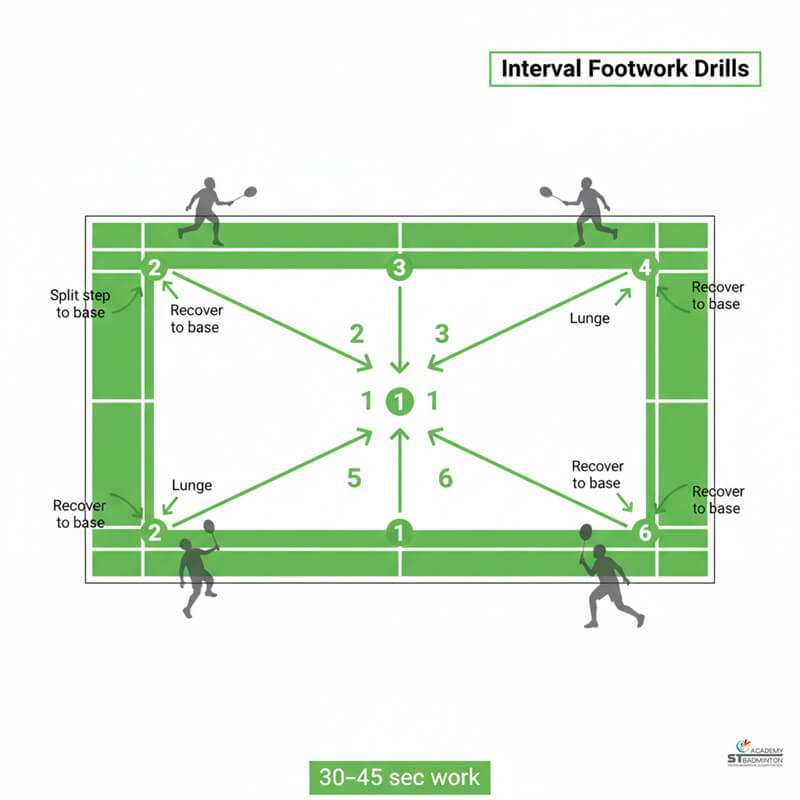
Endurance Drill #1
Interval Footwork Drills
Interval footwork drills form the foundation of badminton-specific endurance training for players in Malaysia and Singapore. These structured on-court movements train your body to recover quickly between rallies while maintaining proper technique. A certified badminton coach at ST Badminton Academy guides players through six-point or four-corner patterns, moving from base position to each corner and back with correct split steps and lunges.
The work to rest ratio matters greatly. Beginners in Setapak, Wangsa Maju or Cheras might start with 30 seconds of movement followed by 30 seconds rest, repeated for 6 to 8 sets. More advanced players can progress to 45 seconds work with only 15 seconds rest. The key is maintaining landing quality, split step timing and recovery posture even when tired.
Players doing these drills 2 to 3 times per week typically notice better stamina and sharper footwork within 6 to 8 weeks. This is not random running but deliberate badminton movement that trains both your aerobic system and the specific muscle patterns needed in matches across Kuala Lumpur, Selangor and Singapore courts.
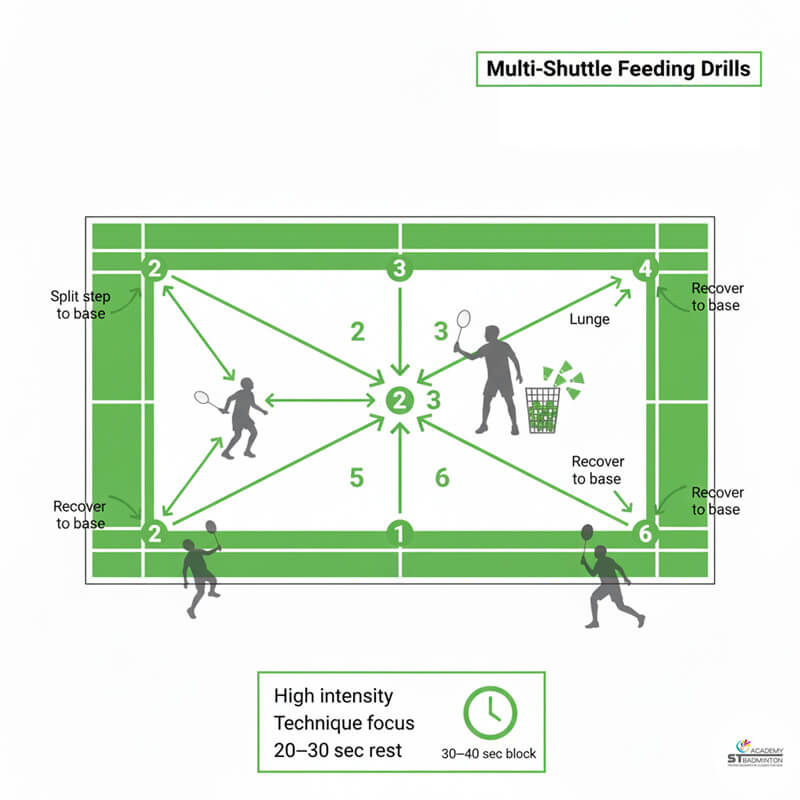
Endurance Drill #2
Multi-Shuttle Feeding Drills
Multi-shuttle feeding drills are among the most effective methods for building badminton-specific endurance while maintaining stroke technique. During these drills, a certified badminton coach feeds shuttles rapidly across different court areas, forcing the player to retrieve each one with correct footwork and proper stroke mechanics. This creates high intensity work periods that closely mirror match conditions.
At ST Badminton Academy, we typically use 30 to 40 second feeding blocks with 20 to 30 seconds rest between sets. The coach varies shuttle placement, requiring the player to move forward, backward and sideways while maintaining clean strokes and good recovery to base. Adult players in Kepong, Ampang or Singapore areas like Jurong and Bishan find this particularly valuable because it trains both physical stamina and decision-making under fatigue.
Unlike simple running, multi-shuttle work forces you to time your swing, judge shuttle speed and maintain posture even when breathing hard. Players who include 2 sessions per week of multi-shuttle intervals usually see significant improvement in their ability to sustain quality shots late in matches across Selangor and Singapore clubs.
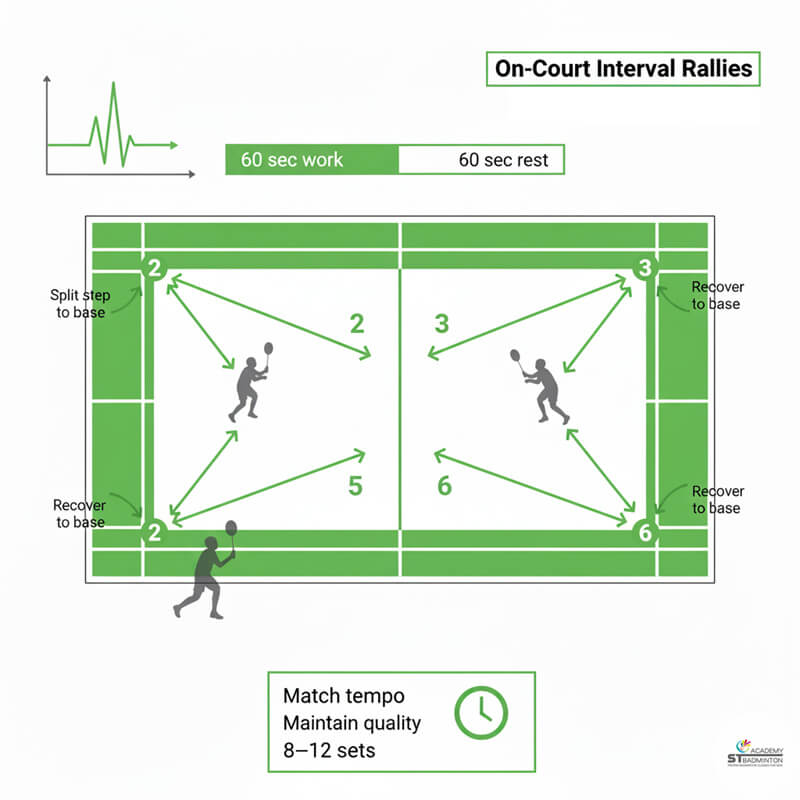
Endurance Drill #3
On-Court Interval Rallies
On-court interval rallies bring game-like conditions directly into endurance training. Instead of drilling in isolation, players engage in timed high intensity rallies that simulate tournament pressure. A common format is 60 seconds of hard rallying at match tempo, followed by 60 seconds rest, repeated for 8 to 12 sets. This trains both physical stamina and mental focus under fatigue.
Another effective variation used at ST Badminton Academy involves playing to 11 points at deliberately high tempo, resting 2 to 3 minutes, then repeating. Players in Cheras, Selayang and Petaling Jaya find this particularly valuable because it forces them to maintain shot quality and tactical awareness even when tired. The rest periods are short enough to stay in an elevated heart rate zone but long enough to attempt full quality in each rally.
Our certified badminton coaches in Malaysia and Singapore emphasize that these interval rallies should not become sloppy scrambles. The goal is to hold proper form and make smart decisions while fatigued, exactly as required in the third game of a close match at club or school team level.
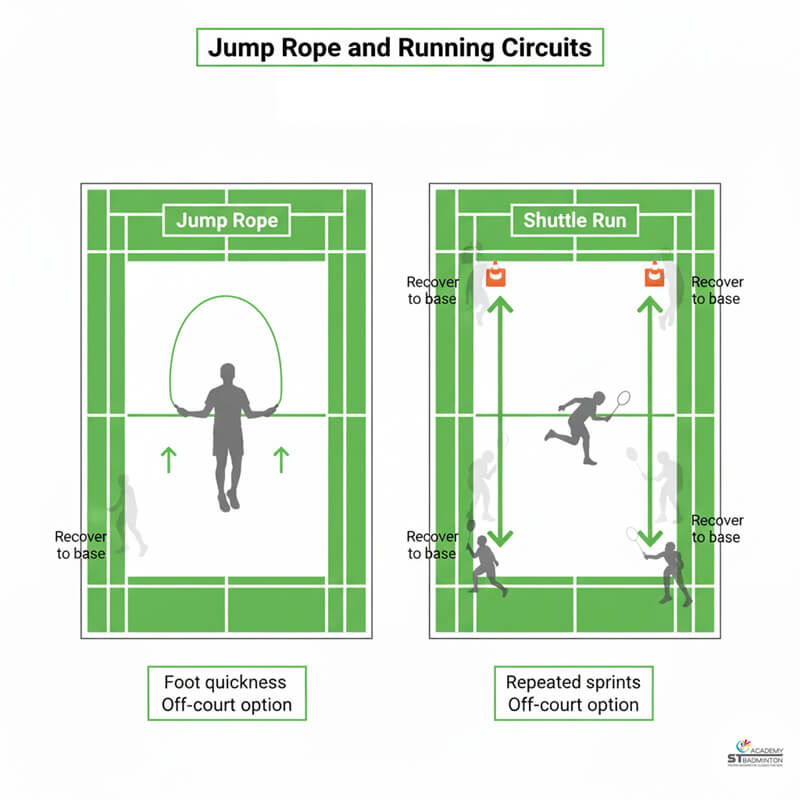
Endurance Drill #4
Jump Rope and Running Circuits
Jump rope and simple running circuits provide valuable support for badminton endurance without requiring court time. Rope skipping develops foot quickness, calf strength and aerobic capacity, all essential for sustained movement in matches. At ST Badminton Academy, we recommend 30 to 60 second continuous skipping intervals with equal rest periods, repeated for 10 to 15 sets as part of off-court conditioning.
Shuttle run drills between court lines or cones also build repeated-sprint ability. A typical circuit might involve sprinting to the service line and back, then to mid-court and back, then to the baseline and back, with 20 to 30 seconds rest between rounds. Players in Gombak, Sentul or Singapore areas like Hougang and Sengkang can do these in any open space.
However, our certified badminton coaches emphasize that these should supplement, not replace, on-court endurance work. Running alone will not teach you to time your split step or recover your racket position under fatigue. Use jump rope and circuits to build general fitness 1 to 2 times per week, but keep the majority of your endurance training on court with racket in hand.
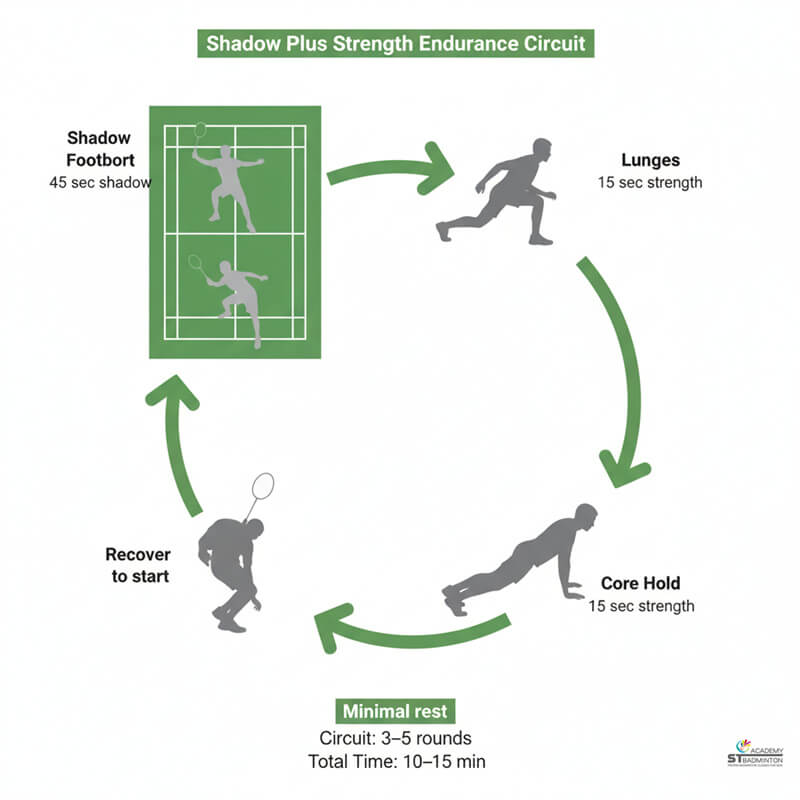
Endurance Drill #5
Shadow Plus Strength Endurance Circuit
Combining shadow badminton with bodyweight strength exercises creates an effective endurance circuit that trains both movement stamina and the muscular endurance needed to maintain good posture late in matches. A basic circuit might include 45 seconds of shadow footwork, followed immediately by 15 seconds of lunges, then 45 seconds more shadow work, then 15 seconds of core holds, with minimal rest between rounds.
At ST Badminton Academy in Setapak, our certified badminton coaches guide players through 4 to 6 rounds of these circuits. The shadow footwork mirrors court movement patterns while the strength work targets legs and core muscles that fatigue during long rallies. Adult players in Subang Jaya, Puchong or Singapore areas like Clementi and Tampines appreciate this format because it builds functional strength without adding bulk or losing flexibility.
Junior players need lighter loads and more frequent breaks than adults. The principle remains the same: train your body to maintain quality movement even when your legs burn and your breathing is heavy, exactly as happens in the final points of a close match across Malaysian and Singaporean school team competitions.
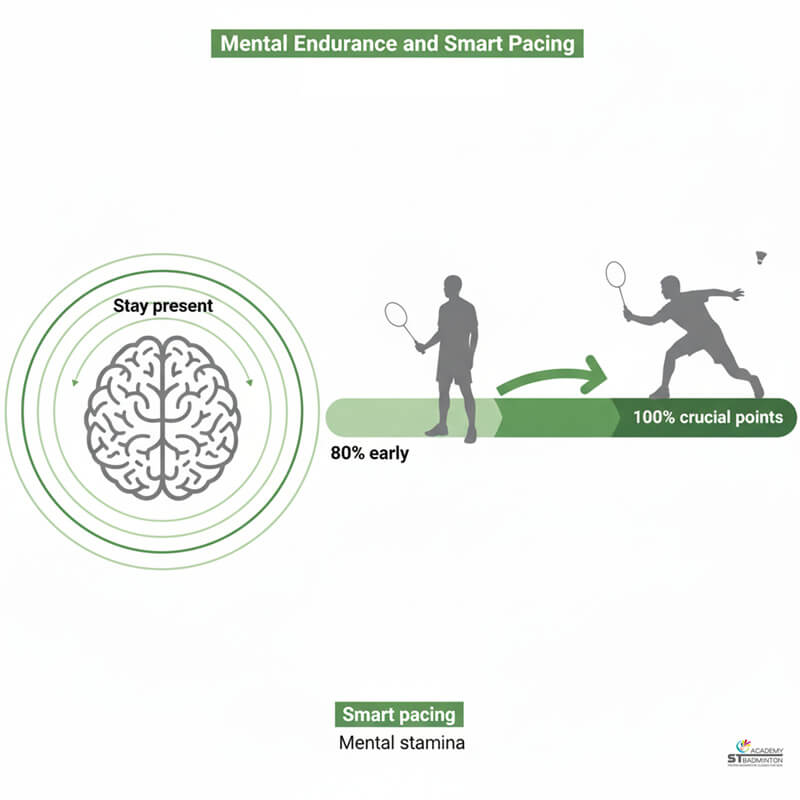
Training Principle
Mental Endurance and Smart Pacing
Physical endurance means little if mental focus collapses when tired. Badminton players in Malaysia and Singapore need to train the mental side of stamina alongside the physical work. During interval drills at ST Badminton Academy, our certified badminton coaches set clear targets for each set, such as reaching a specific number of shuttles or maintaining proper form for the full work period.
This teaches players to stay present and committed even when breathing hard. Another key skill is pacing. Many players in Wangsa Maju, Ampang or Yishun go all out in the first rally, then fade badly. Smart players learn to control intensity early in a match, saving full effort for crucial points. Endurance drills should sometimes include pacing practice, where you deliberately hold back to 80 percent effort for the first few sets, then increase intensity only in the final rounds.
This mirrors real match conditions where you must judge when to push hard and when to conserve energy. Building this awareness through structured training gives you a huge advantage in close matches at club or school team level across Kuala Lumpur, Selangor and Singapore.
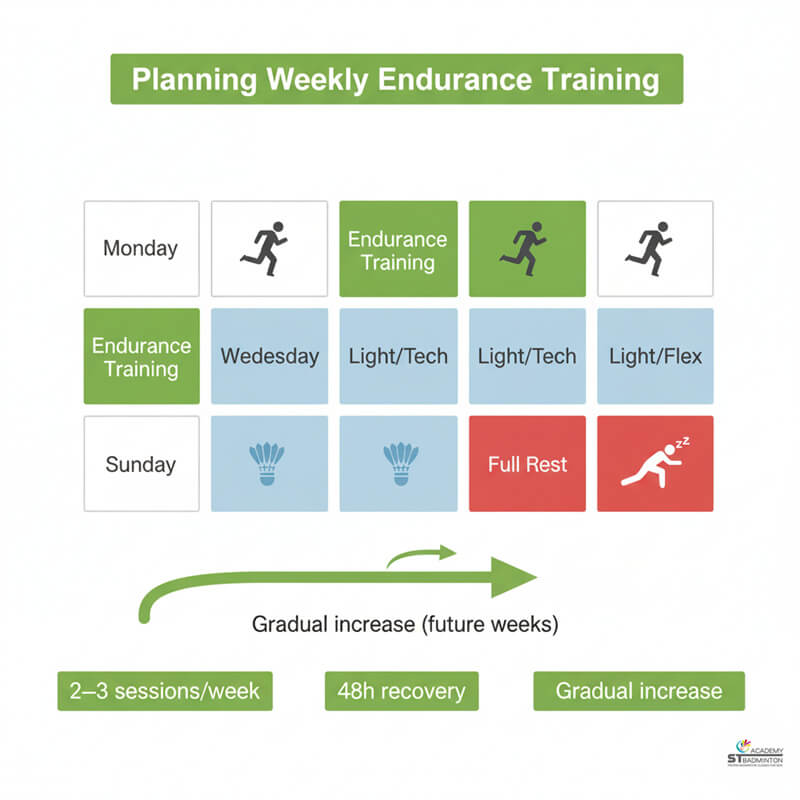
Weekly Planning
Planning Weekly Endurance Training
Effective endurance training requires thoughtful weekly planning, not random torture sessions. For adult club players in Petaling Jaya, Subang Jaya or Singapore, 2 to 3 focused endurance sessions per week is usually enough alongside technical training. A sample week might include one session of interval footwork drills, one session of multi-shuttle work, and one session of on-court interval rallies, with at least one full rest day.
Junior players balancing school and badminton might do one pure endurance session and one mixed technical-endurance session per week. At ST Badminton Academy, our certified badminton coaches emphasize the importance of not stacking maximum sessions back to back. Hard endurance work on Monday, lighter technical work on Wednesday, then hard endurance again on Friday allows proper recovery while still building fitness.
Players in Cheras, Kepong or Bishan who try to do intense intervals every day usually overtrain, lose form and sometimes get injured. Remember that your body adapts during rest, not during the workout itself. Include at least one completely light day and one full rest day every week for best results across your training cycle in Malaysia and Singapore.
FAQs: Best Drills for Building Badminton Endurance
Here are answers to common questions from players in Malaysia and Singapore about building badminton-specific endurance through effective drills.
How often should I do endurance drills for badminton in Kuala Lumpur or Singapore?
Most players benefit from 2 to 3 focused endurance sessions per week. At ST Badminton Academy in Setapak, we recommend spacing these sessions with at least one lighter day between hard efforts and including one full rest day weekly. Adult club players in Wangsa Maju, Cheras or Singapore areas like Jurong typically do one interval footwork session, one multi-shuttle session and one on-court rally session per week alongside their technical training. More than this risks overtraining for most people.
Is running alone enough to build badminton stamina in Malaysia?
No, long slow running builds general aerobic fitness but misses the specific demands of badminton. Badminton requires repeated short sprints, explosive lunges, quick direction changes and recovery between rallies. Our certified badminton coaches in Malaysia and Singapore emphasize that players in Kepong, Selayang or Tampines need on-court interval work like footwork drills and multi-shuttle feeding to train the right energy systems and movement patterns. Running can supplement your training but should not replace badminton-specific endurance drills.
What is the best interval structure for badminton endurance training in Setapak?
A good starting structure is 30 to 45 seconds of work with 15 to 30 seconds rest, repeated for 8 to 12 sets. At ST Badminton Academy, beginners in Setapak or Ampang often start with equal work and rest periods, then gradually reduce rest as fitness improves. The work period should be intense enough that you breathe hard but can still maintain proper footwork and form. Players in Petaling Jaya or Singapore should adjust based on their current fitness level and gradually progress over weeks.
Are these endurance drills suitable for both juniors and adults in KL?
Yes, but with different loads and volumes. At ST Badminton Academy, juniors typically do shorter work periods and more rest than adults. A 14-year-old player in Cheras or Bishan might do 30 seconds work with 30 seconds rest, while an adult in Subang Jaya or Clementi could handle 45 seconds work with 15 seconds rest. Our certified badminton coaches adjust intensity and volume based on age, training experience and current fitness level to ensure safe progression for everyone.
How long will it take to see better endurance on court in Malaysia or Singapore?
Most players notice improvement within 6 to 8 weeks of consistent training. Players in Wangsa Maju, Selayang or Hougang who do 2 to 3 endurance sessions per week typically find they can maintain intensity deeper into games and recover faster between rallies after about two months. Our certified badminton coaches at ST Badminton Academy emphasize that progress requires regular sessions, not occasional heroic efforts. Patience and consistency matter more than short-term intensity.
Should I do endurance drills before or after technical training in Kuala Lumpur?
Generally do technical training first while you are fresh, then endurance work after. At ST Badminton Academy in Setapak, players in Kepong, Gombak or Singapore typically spend the first part of their session on stroke mechanics and tactical drills, then finish with interval footwork or multi-shuttle endurance sets. This ensures proper technique during skill work while still building stamina. On dedicated endurance days, you can do intervals first since technique is not the main focus that session.
What are signs of overtraining from too many endurance drills in Malaysia?
Watch for persistent fatigue that does not improve with rest, declining performance despite training, increased resting heart rate, poor sleep quality and frequent minor injuries or illness. Players in Cheras, Ampang or Sengkang who push too hard often feel exhausted before sessions even start. Our certified badminton coaches in Malaysia and Singapore recommend including full rest days, varying intensity across the week and listening to your body. If you feel constantly drained, reduce training volume and consider discussing your load with a coach or doctor.
Can I do jump rope and running circuits instead of on-court drills near Setapak?
Jump rope and running circuits are useful supplements but should not replace on-court endurance work. These off-court exercises build general fitness and repeated-sprint ability, which helps your badminton. However, only on-court drills with racket in hand teach you to maintain proper technique, split step timing and tactical awareness under fatigue. At ST Badminton Academy, we recommend using jump rope and circuits 1 to 2 times per week alongside, not instead of, your main on-court endurance sessions in Kuala Lumpur or Singapore.
Do I need special equipment for endurance drills at home in Wangsa Maju or Jurong?
Not much. A jump rope, some open space for shadow footwork and bodyweight exercises are enough for basic home endurance training. Players in Wangsa Maju, Sentul or Singapore can do shadow circuits, rope skipping intervals and simple strength endurance work without any court access. However, our certified badminton coaches emphasize that you still need regular court time for multi-shuttle feeding, interval rallies and footwork drills that include actual shuttle contact and decision-making under fatigue.
Badminton Endurance Training in Action
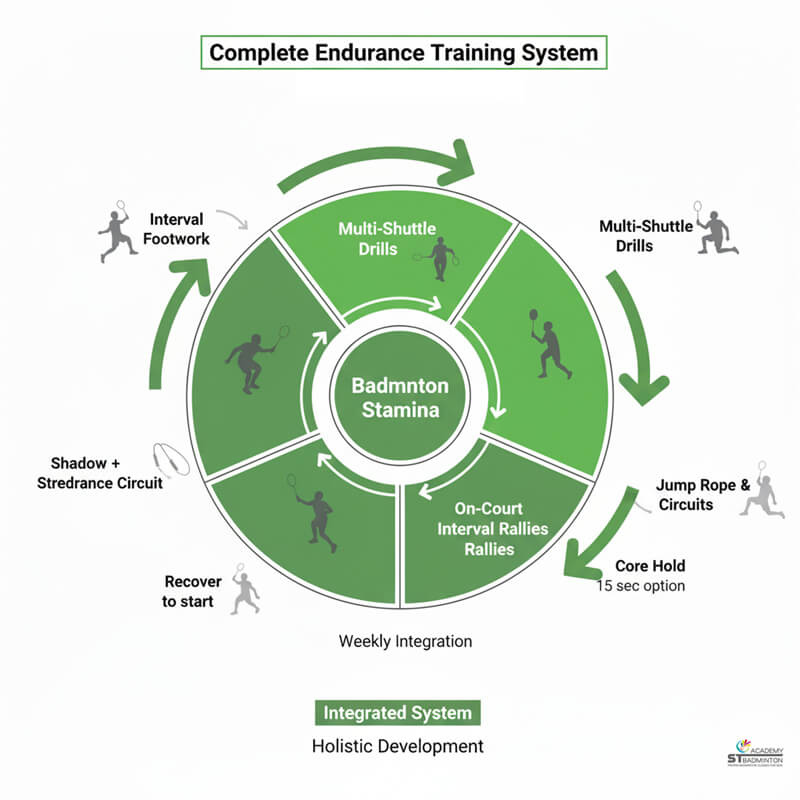



Benefits of Structured Badminton Endurance Drills
Training with the right drills, proper intervals and smart progression gives huge advantages for match stamina and performance. Our approach helps players in Malaysia and Singapore build endurance that actually transfers to better results in tournaments and club matches, not just fitness for the sake of fitness.
| Training Aspect | Random Approach | ST Badminton Academy Structured Drills EFFECTIVE |
|---|---|---|
| Energy System Training | Just run long distances slowly without considering badminton-specific demands. | Interval drills that train both aerobic and anaerobic systems with proper work-rest ratios. |
| Movement Quality | Ignore technique when tired. Just move fast without proper form or footwork patterns. | Maintain split step, landing quality and recovery posture even during high-intensity intervals. |
| Drill Specificity | Generic running and fitness work with no racket or shuttles involved in training. | Multi-shuttle feeding, interval rallies and shadow work that mirror actual match conditions. |
| Weekly Planning | Do maximum effort every single day or train randomly whenever you feel like it. | 2-3 focused sessions per week with planned rest days and progressive overload over time. |
| Mental Training | Only focus on physical tiredness without any mental pacing or focus strategies. | Train decision-making under fatigue and teach smart pacing for tournament conditions. |
| Progression Safety | Push maximum intensity from day one without gradual increases or recovery periods. | Start with shorter intervals and fewer sets, increase one variable at a time over weeks. |
| Coaching Guidance | Train alone without feedback or correction from experienced coaches during drills. | Certified badminton coaches guide work-rest ratios, correct form and adjust load for each player. |
Structured Endurance Training for Badminton Players in Malaysia and Singapore
This guide explains which drills are most effective for building badminton-specific endurance and how to organize them into practical weekly training plans. ST Badminton Academy provides coaching in interval footwork drills, multi-shuttle feeding, on-court rallies and smart conditioning work for school team players, serious juniors and adult learners in Setapak, Wangsa Maju, Cheras, Selayang and surrounding Kuala Lumpur areas, as well as for players across Singapore. Contact us to discuss how structured endurance training can help you maintain quality play deeper into matches. Please note this is general educational information and not medical advice. Anyone with heart conditions, dizziness or unusual symptoms should consult a doctor before intense training.




